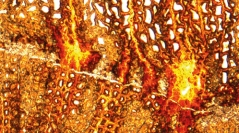

 Geodiversitas
42 (23) - Pages 427-441
Geodiversitas
42 (23) - Pages 427-441A new fossil pine species from eastern Turkey is described and its botanical affinities are discussed. The sample was collected from the city of Kemaliye, Erzincan province, Turkey, and derives from the early-middle Miocene Divriği formation. Transverse, tangential and radial sections were taken from the petrified wood, and its palaeoxylotomical features were investigated. Based on its anatomical features including idioblastic cells in rays a new fossil-species of the genus Lesbosoxylon Süss & Velitzelos was identified as Lesbosoxylon kemaliyensis Akkemik & Mantzouka, sp. nov. Diagnostic features of the new species are: Transition from earlywood to latewood mostly gradual; axial and radial resin canals with thin-walled epithelial cells present; latewood tracheids thin to thick walled; bordered pits on radial walls of tracheids 1-2(-3) seriate; crassulae common; rays heterocellular, uniseriate, partly biseriate; uniseriate rays up to 27 cells high; fusiform rays up to 30 cells high; axial parenchyma occasionally present; ray tracheids 2-3 rows; cell walls of ray tracheids smooth; cross-field pitting pinoid, 1-2(-6) pits per cross-field. Detailed investigation of the botanical affinities of the new fossil wood suggested that the most closely related modern species is Pinus canariensis C. Sm in Buch, a relict species from the Canary Islands.
Pinaceae, Miocene, Sivas Basin, wood anatomy, conifer, biogeography, new species